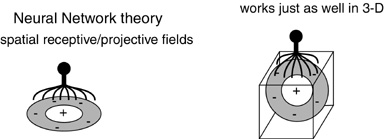
| Back | Return to Beginning | Next |
So what kind of mechanism in the brain could possibly produce volumetric spatial structures?
In neural network theory spatial patterns are detected by way of spatial receptive fields, that is, neurons with a spatial pattern of excitatory and inhibitory synapses designed to trigger the cell body to activation in the presence of a matching pattern of activation in the cell's receptive field. And for generating spatial patterns the cell body can project a projective field in the synaptic pattern of its axon collaterals, so that activation of the cell body would "print" or "paint" its corresponding pattern in the neural tissue.
This concept works just as well in three dimensions as in two.

But this is no different than a template theory, because it requires a separate template for every pattern that is to be represented, and thus leads to a combinatorial explosion in the required number of receptive fields.
For example hold up your hand in front of you. If the picture of your hand in your experience is a pattern of activation in your brain, then neural network theory would suggest that there is a cell in your brain whose projective field has the shape of the configuration of your hand as you perceive it, so that activation of its cell body would "paint" the volumetric picture of your hand in your experience.

But you would have to have a separate cell with projective fields for every possible location where your hand might need to appear, and at every orientation at every location in three dimensions, not to mention a whole separate set of such receptive fields to paint your hand in every possible posture or configuration.
This principle is clearly problematic and totally unworkable. No wonder so many neuroscientists are naīve realists!
| Back | Return to Beginning | Next |